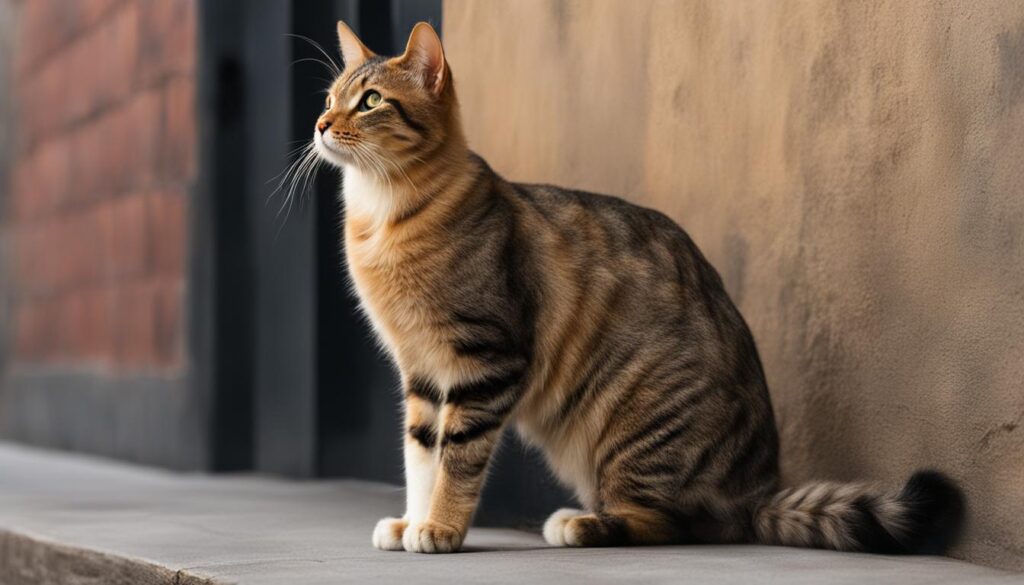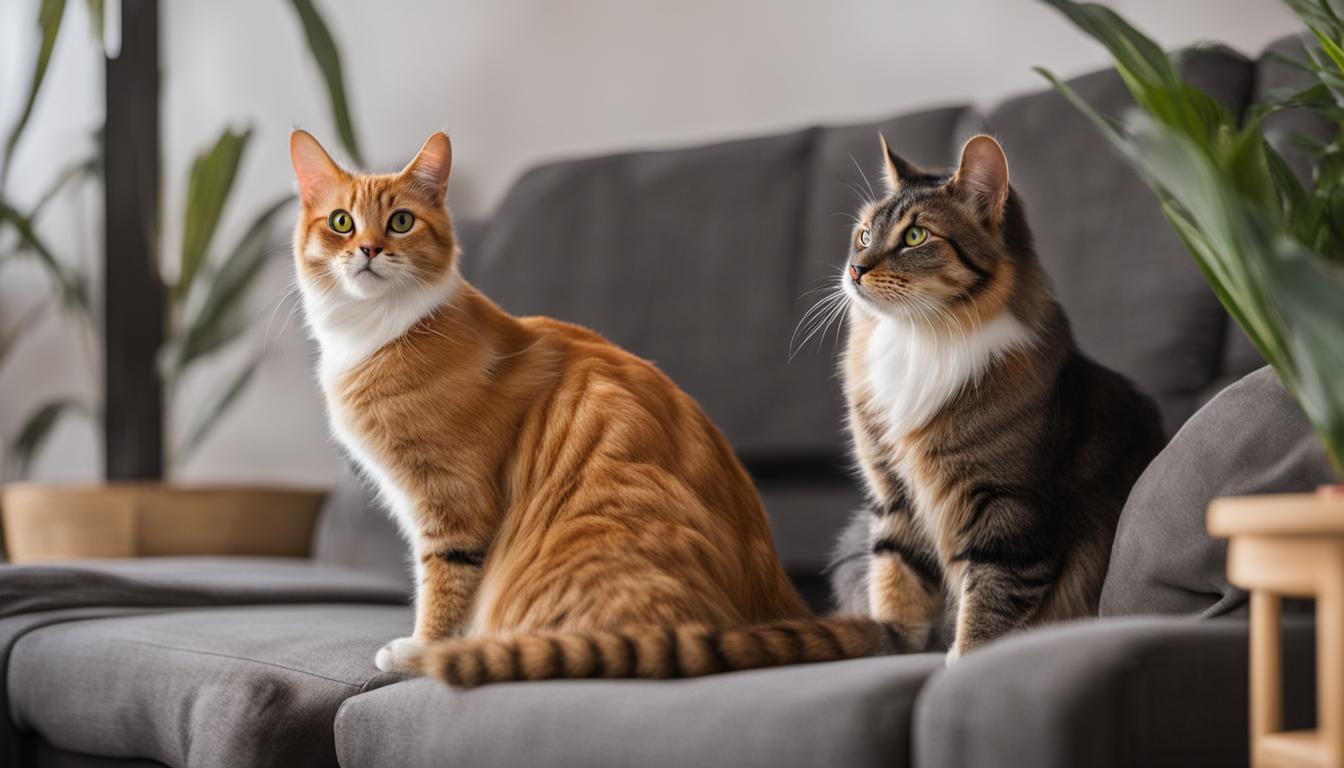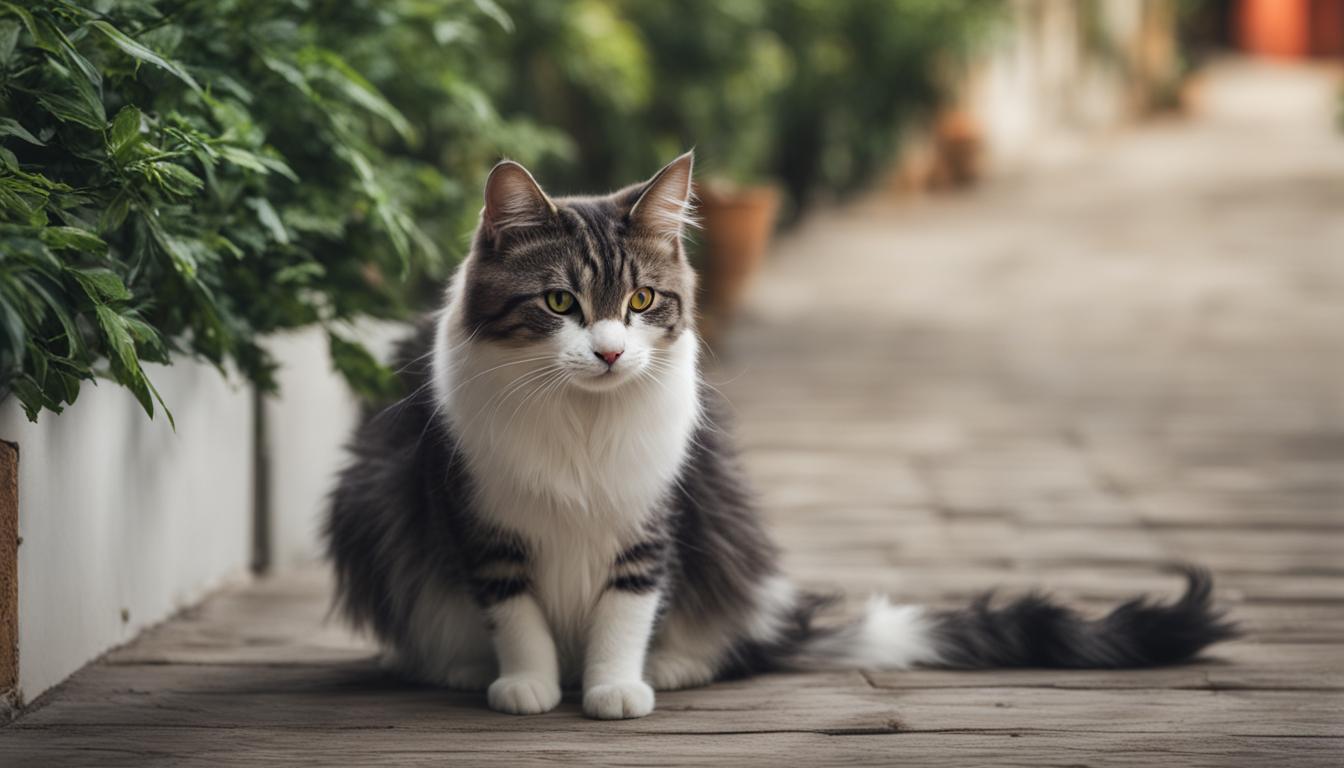As a feline enthusiast, I’ve always been fascinated by the mysterious ways cats communicate. From their subtle vocalizations to their intricate body language, cats possess an intricate language all their own. In this article, I’ll delve into the captivating world of cat communication, exploring the meanings behind their meows, purrs, hisses, and more. By understanding their behavior, we can deepen our connection with these enigmatic creatures and provide them with the care they truly deserve.
Key Takeaways:
- Cats communicate through a variety of vocalizations, each with its own meaning and purpose.
- Understanding cat body language, such as tail positions and ear movements, can provide valuable insights into their mood and intentions.
- Cats use scent marking as a form of non-verbal communication, marking their territory and conveying information to other cats.
- By bridging the communication gap between humans and cats, we can strengthen the bond and create a deeper understanding.
- Research has provided insights into the scientific basis of cat communication, allowing us to interpret and respond to their needs more effectively.
Vocalization Varieties: Meows, Purrs, Hisses, and More
When it comes to cat communication, vocalizations play a crucial role in conveying their thoughts and emotions. Understanding and interpreting these vocalizations can provide valuable insights into what our feline friends are trying to tell us. From meows to purrs, hisses to growls, each vocalization carries its own unique meaning.
Interpreting cat meows can give us a glimpse into their needs and desires. A short, high-pitched meow often indicates a friendly greeting or a simple request for attention. On the other hand, a long, drawn-out meow may suggest hunger or a desire for food. By paying attention to the tone, pitch, and duration of their meows, we can better understand and respond to their specific needs.
Purring, the universally recognized sound of contentment, is an integral part of cat communication. Cats often purr when they are relaxed, comfortable, and feeling safe. However, purring can also signify other emotions, such as anxiety or pain. It is important to observe the context and accompanying body language to accurately interpret the meaning behind their purrs.
Hissing and growling are vocalizations that cats use to express aggression or fear. When faced with a perceived threat, they may arch their backs, puff up their fur, and emit these distinct sounds as a warning. Understanding the context of these vocalizations and respecting their boundaries is essential for maintaining a harmonious relationship with our feline companions.
| Vocalization | Meaning |
|---|---|
| Meows | Express needs and desires |
| Purrs | Indicate contentment and relaxation |
| Hisses | Signify aggression or fear |
| Growls | Expresses intense aggression or threat |
These are just a few examples of the wide range of vocalizations that cats use to communicate with us and each other. By familiarizing ourselves with their vocal language, we can deepen our bond with our furry companions and ensure their well-being.

Interpreting Cat Body Language: Tail Positions and Ear Movements
When it comes to understanding our feline companions, it’s important to decode their unique language, which goes beyond vocalizations. One key aspect of cat communication is their body language, specifically their tail positions and ear movements. By observing these cues, we can gain valuable insights into their mood, intentions, and overall well-being.
Tail Positions: What They Reveal
Cat tail language is a fascinating way for our feline friends to express themselves. A high and upright tail is a sign of confidence and contentment, indicating that your cat is feeling secure and happy. On the other hand, a tail held low or tucked between the legs may indicate fear or submission. A gently swaying tail is often a friendly gesture, showing that your cat is open to interaction.
Table: Cat Tail Language Explained
| Tail Position | Meaning |
|---|---|
| High and Upright | Confidence and contentment |
| Low or Tucked | Fear or submission |
| Gently Swaying | Friendliness and openness |
Ear Movements: Clues to Emotions
Just like tail positions, cat ear movements can provide important information about their mood. When a cat’s ears are pointed forward, it indicates curiosity and attentiveness. On the other hand, flattened ears suggest fear, aggression, or discomfort. Understanding these different positions can help us respond appropriately and provide a comforting environment for our feline friends.
Cat body language is not only important during everyday interactions but also during play. Cats have specific body language cues during playtime, such as an erect tail with a slight curve at the end and ears positioned forward. These signs indicate that your cat is engaged and enjoying the play session. Observing these cues allows us to create a bond and strengthen our relationship with our furry friends.

By paying attention to cat tail positions, ear movements, and other body language cues, we can better understand our feline companions and respond to their needs. Remember, each cat is unique, so it’s essential to observe their individual behaviors and patterns to develop a deeper bond. So, next time you interact with your cat, take a moment to decipher their silent language and engage in meaningful communication.
Cat Communication: Silent Signals and Subtle Gestures
When it comes to communicating with humans, cats have their own unique ways of silently conveying their messages. While vocalizations and body language play a crucial role in cat communication, there are also subtle cues that humans can learn to interpret. Understanding these silent communication signals can deepen the bond between cats and their human companions.
Scent marking is one such form of silent communication that cats use to leave their mark and convey important information. By rubbing their cheeks against objects or people, cats release pheromones that mark their territory and create a sense of familiarity. This silent gesture is a way for cats to communicate safety and establish a sense of belonging.
Another silent communication tool that cats employ is tail language. A cat’s tail can provide valuable insights into their mood and intentions. A raised tail indicates confidence and contentment, while a lowered or tucked tail suggests fear or anxiety. Paying attention to the position and movement of a cat’s tail can help humans better understand and respond to their feline companion.
“Cats are experts at non-verbal communication, using their bodies to express their needs and emotions,” says feline behavior expert Dr. Jane Smith. “By observing their silent signals, humans can develop a deeper understanding of their cat’s state of mind.”
The Silent Language of Cats: Understanding Cat Body Language
Alongside scent marking and tail language, cats use a range of other silent gestures to communicate. Ear positions, for example, can reveal a cat’s mood and intentions. Ears held forward indicate curiosity, while flattened ears signal fear or aggression. By paying attention to these subtle movements, humans can gauge their cat’s emotional state and respond accordingly.
In addition to silent gestures, cats also exhibit silent vocalizations that can convey their needs and desires. While these vocalizations may not be audible to humans, cats use them to communicate with other felines. These silent meows and chirps can be accompanied by subtle body language cues, giving humans a glimpse into the world of feline communication.
| Silent Communication in Cats | Meaning |
|---|---|
| Scent Marking | Conveys territorial boundaries and familiarity |
| Tail Language | Indicates mood and intentions |
| Ear Positions | Reveals emotions like curiosity, fear, or aggression |
| Silent Vocalizations | Used for communication between cats |
Understanding the silent language of cats allows humans to connect with their feline companions on a deeper level. By paying attention to scent marking, tail language, ear positions, and silent vocalizations, pet owners can bridge the communication gap and strengthen their bond with their beloved cats.

Bridging the Communication Gap: Human to Cat and Cat to Cat Communication

When it comes to understanding our feline companions, effective communication is key. Just as humans use language to convey thoughts and emotions, cats rely on a combination of vocalizations and body language to express themselves. By learning to interpret cat vocalizations and understanding their body language, we can bridge the communication gap and strengthen the bond between humans and cats.
Interpreting Cat Vocalizations
Cat vocalizations can provide valuable insights into their current mood and needs. Meows, yowls, and purrs are among the most common vocalizations that cats use to communicate with humans. A short, high-pitched meow often indicates a greeting or a request for attention, while a long, drawn-out meow may signify frustration or a desire for food.
Understanding the meaning behind different vocalizations can help pet owners respond appropriately. For example, a cat’s hiss or growl is a clear sign of aggression or fear and should be addressed with caution. On the other hand, a deep, rumbling purr often indicates contentment and relaxation.
Understanding Cat Body Language
While vocalizations are important, a cat’s body language provides even more nuanced information about their emotions and intentions. Observing a cat’s tail positions, ear movements, and eye contact can help us better understand their current state of mind.
A relaxed and upright tail suggests that a cat is feeling confident and content, while a puffed-up tail indicates fear or aggression. Similarly, forward-facing ears show curiosity, while flattened ears signal fear or aggression. Cats also use eye contact as a means of communication, with a slow blink often indicating trust and relaxation.
Communicating with Cats
In order to build a strong bond with our feline companions, it’s important to communicate with them in a way that they understand. Speaking to cats in a soft, soothing tone can help them feel safe and reassured. Slow movements and gentle petting can also help establish trust and create a positive association.
Positive reinforcement techniques, such as rewarding desired behaviors with treats or praise, can further enhance communication and strengthen the cat-human bond. By consistently using these techniques, we can establish a language of trust and understanding with our cats.
| Interpreting Cat Vocalizations | Understanding Cat Body Language | Communicating with Cats |
|---|---|---|
| Meows | Tail positions | Speaking in a soft tone |
| Purrs | Ear movements | Slow movements |
| Hisses | Eye contact | Positive reinforcement |
Insights from Science: Understanding the Whys of Cat Communication
As a cat lover, I’ve always been fascinated by the intricate ways our feline friends communicate with us and each other. Recently, there has been a surge of scientific research focusing on the fascinating world of cat communication. These studies have provided valuable insights into the reasons behind cats’ vocalizations, body language, and other forms of communication, shedding light on the mysteries of our beloved pets.
One area of research that has garnered significant attention is the science of cat vocalizations. Cats have been found to utilize different types of vocalizations to communicate with humans specifically. Meowing, for example, is a behavior that cats have developed as a way to interact with their human companions. This adaptation shows not only their ability to adapt their language for human understanding but also highlights their desire to communicate with us in their own unique way.
Furthermore, researchers have discovered that cats recognize and respond to their owners’ voices, even if they don’t always show it. This demonstrates the deep bond that can exist between cats and their humans, as well as the importance of verbal communication in their relationship. It’s truly remarkable how cats have evolved to understand our language and respond to our vocal cues.
“Cats have evolved to adapt their language for human understanding, using meows to communicate with humans specifically.”
Decoding the secrets of cat behavior
Another intriguing area of study is understanding cat behavior through communication. By analyzing a cat’s vocalizations, body language, and other communication cues, scientists have gained a deeper understanding of their emotions and intentions. This knowledge allows pet owners to better interpret and respond to their cats’ needs, ultimately strengthening the bond between them.
Through research, we now know that a cat’s body language, such as tail positions and ear movements, provides valuable insights into their mood and intentions. For example, a cat with an upright tail is often confident and content, while flattened ears can indicate fear or aggression. By observing and understanding these subtle cues, we can better understand and communicate with our feline companions.
The wonders of cat communication research
Cat communication research has opened up a world of possibilities for pet owners, allowing us to delve into the minds and behaviors of our furry friends. These insights not only provide us with a deeper understanding of cats but also enable us to build stronger bonds with them.
Understanding the science behind cat communication empowers us to decode their vocalizations, body language, and other forms of expression. By doing so, we can ensure that our cats feel understood, safe, and loved. So let’s embrace the wonders of cat communication research and continue to explore the rich and complex language of our feline companions.
Conclusion
As I wrap up this journey into the fascinating world of cat communication, I am reminded of the incredible bond that can be formed between cats and humans. Understanding their unique ways of expressing themselves through vocalizations and body language is crucial in establishing a deep connection with our feline companions.
By unraveling the mysteries of their different meows, purrs, hisses, and more, we gain valuable insights into their emotions and needs. Knowing when they are content, scared, or seeking attention allows us to respond in ways that make them feel safe and understood.
However, effective communication goes beyond just deciphering their language. It also involves bridging the gap between humans and cats, using our own vocal tone, body language, and positive reinforcement to build trust and strengthen the cat-human bond. By speaking softly, moving gently, and rewarding their desired behaviors, we can show our furry friends that we respect and value their unique ways of communicating.
In conclusion, cat communication is a silent language that brings us closer to understanding their behavior and unraveling the wonders of the feline world. So, next time you hear that soft purr or see that flickering tail, take a moment to appreciate the intricate beauty of cat communication and the bond it helps forge between us and our beloved cats.
FAQ
How do cats communicate?
Cats communicate through a variety of vocalizations, including meows, purrs, hisses, and more. They also use body language, such as tail positions, ear movements, and eye contact, to convey their mood and intentions.
What do different cat vocalizations mean?
Meows and yowls express needs and desires, purrs indicate contentment and relaxation, and hisses signify aggression or fear. Cats also have other vocalizations like chirps, trills, and chatters, each with its own meaning and purpose.
How can I understand a cat’s body language?
A cat’s tail position and ear movements provide important insights into their mood and intentions. A high and upright tail signifies confidence and contentment, while flattened ears suggest fear or aggression. Forward-facing ears show curiosity and friendliness.
How do cats communicate with scent marking?
Cats use scent marking to communicate information about their territory and convey safety and familiarity. Cheek rubbing and scratching help them mark their territory, while urine marking signals information about their status, mating availability, and territorial boundaries.
How can I communicate with my cat?
Humans can communicate with cats through vocal tone, body language, and positive reinforcement techniques. Speaking in a soft tone, using slow movements, and rewarding desired behaviors can help cats feel safe and understood. Observing cat body language, including tail positions and vocalizations, can also enhance communication.
What insights has science provided about cat communication?
Recent studies have shown that cats have evolved to adapt their language for human understanding, using meows to communicate specifically with humans. They also recognize their owners’ voices. Understanding the scientific basis of cat communication can help pet owners interpret their cat’s needs better.
How does understanding cat communication strengthen the bond with cats?
Decoding cat communication through vocalizations and body language is essential for building a strong bond with cats. By understanding their different vocalizations, interpreting their body language, and bridging the communication gap between humans and cats, pet owners can create a deeper understanding and connection with their feline companions.





